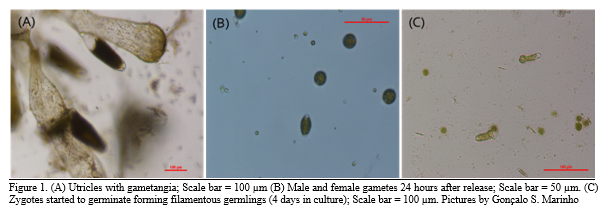SEXUAL REPRODUCTION IN THE GREEN MACROALGA Codium tomentosum – A “NEW SPECIES” FOR AQUACULTURE
Introduction
AquaVitae (AV) is a research and innovation project funded by the European Union’s Horizon 2020 program. AV’s overall objective is to introduce new, and expand existing, low trophic species products and processes to marine aquaculture value chains across the Atlantic. Diversification of macroalgae production is paramount if macroalgae are to reach their full potential for the provision of food, feed, and biomass for many other applications. Therefore, species of macroalgae not yet fully exploited commercially but with recognised potential were investigated to optimise production conditions.
Codium tomentosum is a valuable source of food and biomass, which is currently cultivated at a pilot scale in land-based aquaculture. Cultivation is carried out through biomass fragmentation followed by vegetative propagation in tumble culture, which may result in reduced genetic diversity and reduce technology options for its cultivation.
To develop a new hatchery protocol based on sexual reproduction to produce seedlings of C. tomentosum it is essential to understand the basic reproduction biology of the species. Sexual reproduction in the Codium genus is performed through zygotes resulting from the gamete fusion. The zygote germinates into a diploid germling, a siphonous filament, which eventually develops into the adult thalli. The peak of sexual maturation for C. tomentosum has been reported to be reached in winter, but no comprehensive analysis on the seasonal reproductive status of the species has been done until now. Moreover, the control of the life cycle under artificial culture conditions is challenging and has not been achieved so far.
This study aims to evaluate the effect of the season and culture conditions such as light intensity and spectrum, nutrient concentration, and water movement on the reproductive status, and early stages of development of C. tomentosum. The ultimate goal is to define optimized culture conditions for sexual reproduction, which will form the basis for the future establishment of hatchery protocols for seedling production.
Material and methods
Specimens of Codium tomentosum were collected from two natural populations from Northern Portugal: Aguçadoura shore (41° 26′ N, 8° 47′ O), located in Póvoa de Varzim, and Viana- Norte (41°41’49.3"N, 8°51’03.4"W), located in Viana do Castelo. The biomass has been collected monthly or bi-monthly since January 2020 for evaluation of seasonal variation in the reproductive status.
The species identification, observation of reproductive structures, gamete release, zygote formation, and early stages of development were followed through microscopic observation. Images were recorded with a coupled camera, and post-processed (e.g. measurements) using ImageJ software.
The effect of the light spectrum (white, blue, green, and red) and intensity (20, 40, and 60 μmol m−2 s−1), nutrient medium concentration (PES, PES/2, PES/10, and natural seawater), and water movement on the early stages of development of C. tomentosum was investigated.
Results
The absence of mucron in the apical part of the utricles indicates that the biomass collected from natural populations corresponds to C. tomentosum, and not the co-existing invasive C. fragile.
The presence of reproductive structures, gametangia (Figure 1A), which are indicative of the reproductive status of the specimens, was observed in the samples collected in January and March 2020, they were absent in the samples collected in May and June 2020, and then were observed again in the samples collected from August 2020 to March 2021. The reproductive status was further confirmed by the liberation of gametes, zygote formation and germination.
Both male and female gametes were successfully released and identified (Figure 1B), and after a few days in culture, the development of a zygote could be observed. After approximately 3 to 7 days each zygote germinated into a filamentous germling (Figure 1C). The germlings obtained from the specimens collected in the winter months (December 2020 and January 2021) presented a faster development than those obtained from specimens collected in any other month. Nevertheless, even after some months in culture, the formation of adult thallus could not be observed.
Regarding the culture conditions, the filamentous germlings had a faster development when exposed to a light intensity of 20 µmol m-2 s-1, compared to 40 or 60 µmol m-2 s-1, regardless of the light spectrum applied. Moreover, the green, red, and white light spectra resulted in faster development than the blue. The germlings performed better when grown in PES medium at normal concentration compared to those grown at lower concentrations (PES/2 and PES/10), or natural seawater alone. Moreover, preliminary results suggest that water movement promotes the development of the germlings compared to cultures kept without movement. The germlings developed (in length) for several weeks, and after some weeks some branching could be observed. However, even after some months in culture, the formation of adult thallus could not be observed.
Discussion
The results showed that C. tomentosum from the studied natural populations is reproductive most of the year with exception of a short period in spring-early summer, which matches a period in which an immature new generation of C. tomentosum is emerging for the rocky substrate to form the upright adult thallus replacing almost entirely the former one. This study will continue for another year to confirm the observed pattern.
Culture conditions that promote the development of germlings have been identified with respect to light intensity and spectrum, nutrient concentration, and water movement. Nevertheless, even after some months in culture, the development of upright adult thallus was not achieved. This suggests that the culture conditions required to induce the morphogenesis of germlings to form the spongy thallus may not be the same that favor the development of the filamentous germlings. Further multifactorial trials will focus on the specific condition required to induce the morphogenesis and thereby obtain seedlings of C. tomentosum.
Acknowledgments
This study/AquaVitae project has received funding from the European Union’s Horizon 2020 Research and Innovation Programme under Grant Agreement No 818173.
